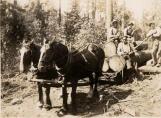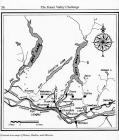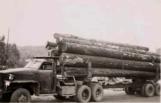1
Getting them Out: Logging Transportation Through The Years2
Over the years, the method of moving timber in the woods and from the woods has evolved from using oxen, horses, and trains to 'donkeys' and logging trucks. This story shows some of the stages in this evolution in the Mission area.4
Between 1860 and 1890 oxen were usually used to move the felled trees in the woods. Around the 1890's oxen were replaced by horses, which were found to be faster and smarter. In the Mission area horses pulled the felled timber to the main logging road and...6
then another team would pull them on a "sleigh" or on a wagon to the mill.8
By the early 20th century, logging had developed into a booming industry.Smaller operations still worked by hand, using oxen and horses, but the larger operators, who were able to afford the newer options were moving to steam power operations in conjunction with the railroads.
By the 1900s, there were four major logging railroads that operated in the Mission and Haney areas (see map). In the Mission area, Abernethy logging (the largest logging operation in the province, at the time) and Heaps Timber ran two main lines. At about this time the invention of the Steam Donkey enabled logging companies to use steam, rather than horses to skid logs from the woods to the railway. The Steam Donkey also allowed them to use steam power to load logs onto railcars.
9
Folke Lindell and Pete Lowe. With truck used to carry railroad ties.1927
Keystone Road, Mission, BC





